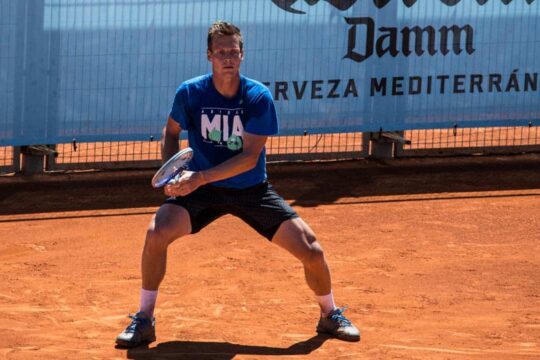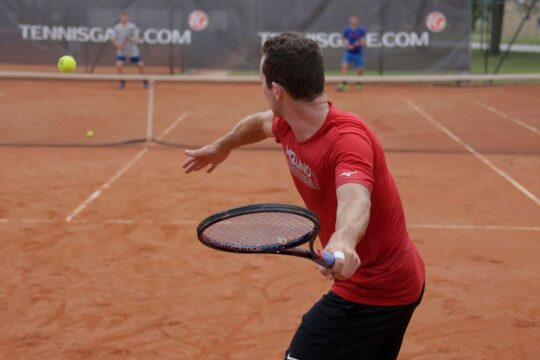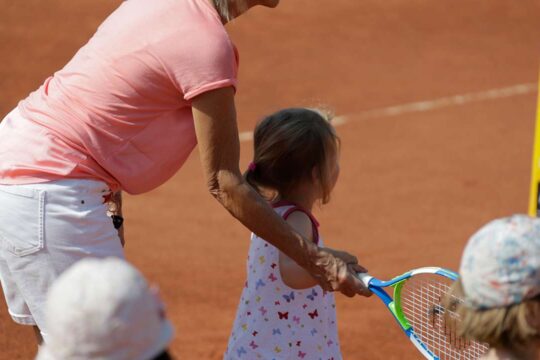How to Volley in Tennis: Video Tips, Drills, & Common Mistakes
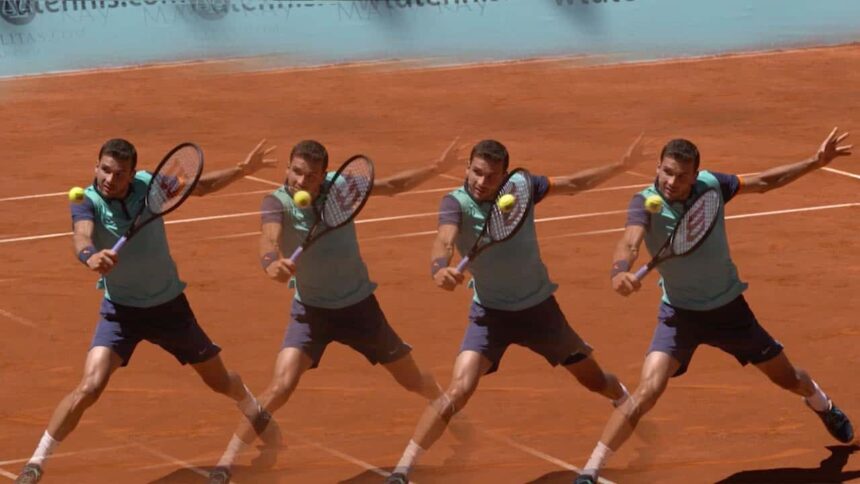
The strategy in tennis has changed in the last 30 years, favoring the baseline game more and more. However, knowing how to volley well is still a very important skill and an absolute necessity, especially in doubles.
The goal of this post is to help you improve your net game, and volley technique. We will cover the following topics:
- How to Hit a Volley in Tennis: Fundamentals & Technique
- The Forehand & Backhand Volleys: Frame-By-Frame
- Common Mistakes on the Volley
- The Best Drills & Tips to Improve Your Volleys
HOW TO HIT A VOLLEY IN TENNIS: FUNDAMENTALS & TECHNIQUE
The biggest difference between the volley and groundstroke is that on the groundstrokes you are trying to impart speed on the ball, while at the net you are trying to use the incoming speed to redirect it.
In other words, you need to think of groundstrokes as “sending” shots, while volleys are better described as “receiving” shots. The best way to think about volleying is to visualize yourself catching the ball, placing the racquet head behind the path of the incoming ball as if it were a net.
Here is a video that will clarify how to receive volleys the right way.
Let’s take a look at specific fundamentals.
THE VOLLEY GRIP
At the net, the best grip to use is the continental grip for both the forehand, and the backhand volley. The continental grip feels like holding a hammer. As if you want to hit something with the frame.
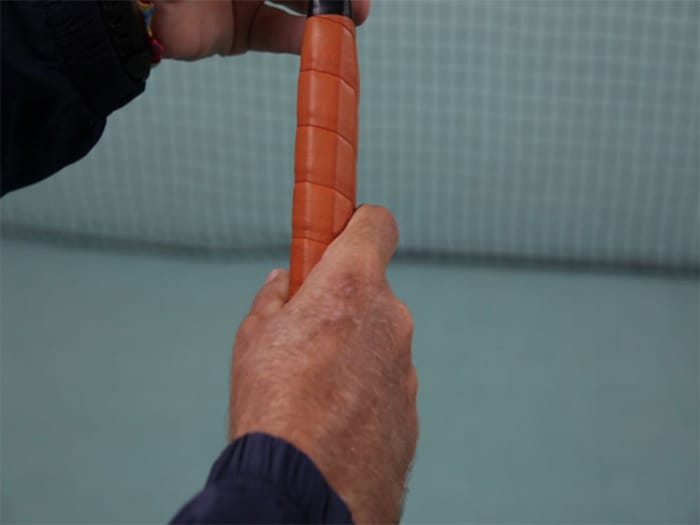
A common mistake it to try to hit a backhand volley with a forehand grip as the video will explain.
FOOTWORK ON THE VOLLEY
At the net, your legs are very important. You have to move fast and you have to move with precision.
Every volley should start with a split step and followed by a step forward or across the body with the opposite leg. That is, a right-handed player will step forward with the left leg on forehand volleys and with the right leg on backhand volleys.
The following three videos will help you improve your footwork at the net.
This video explains how to use the split step on your volleys.
This video will help you make sure you step with the proper leg on the volley with the right timing.
To get enough power on your volleys, you shouldn’t swing harder. Instead, use your body to add power. This video explains how to do that.
THE BACKSWING
It is helpful to think about the backswing on the volleys as placing the strings behind the path of the ball.
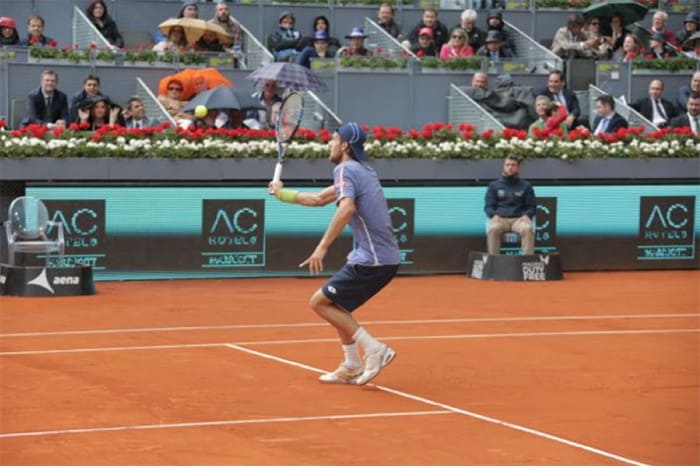
However in some instances the racquet is placed slightly above the contact point and the swing has a slight downward trajectory. In most cases though, thinking about placing the strings behind the incoming ball is the best way to go, especially for beginners.
This video explains how to set your racquet on your volleys.
FORWARD SWING AND CONTACT POINT
Since there is only a very small backswing, the path towards contact is also very short.
If you set the racquet behind the path of the ball, the movement towards contact will be very controlled. However, it is important to understand exactly what the ideal contact is.
On the forehand volley you want to make contact in front of the body with the wrist laid back.
On the backhand volley, the contact is more on the side of the body with the shoulder, elbow, wrist and racquet aligned.
The following video will help you understand the ideal contact point better.
DON’T FOLLOW THROUGH ON YOUR VOLLEYS
Again, volleys are receiving shots. You are not trying to generate power, so the swings is very compact.
Ideally your swing should end close to contact with very little movement of the arm. Next time you are practicing your volleys, freeze your finish every time you hit the ball and check how far the racquet is from contact. It should be quite close.
Let’s take a look at a perfect execution of an approach and volley combination by Tomas Berdych. Pay special attention to the short backswing, stable swing and short follow through.
Now that we have discussed the different aspects of the volley, the following slide shows should help you visualize the execution of both the forehand and backhand volley, frame by frame.
THE FOREHAND & BACKHAND VOLLEYS: FRAME-BY-FRAME
Hitting a good volley can be simple if you have the right technique. As discussed, you need the right grip, backswing, contact, and follow through.
One easy way to make sure you’re hitting volleys correctly is to film your volleys. Then you can compare to the images below to make sure you’re in the right position.
HOW TO HIT HIGH VOLLEYS
The difference between high and low volleys is the size of the swing. As you will see in the slide shows below swings are a little longer when the ball is coming higher and slower.
Forehand Volley Slide Show
Backhand Volley Slide Show
COMMON MISTAKES ON THE VOLLEY IN TENNIS
There are several mistakes we see many players making at the net when it comes to volleys. Here are several mistakes you should avoid.
HITTING BODY VOLLEYS WITH THE FOREHAND
In general most players favor their forehand volley because it is usually the stronger shot. However, for balls at the body the backhand volley is the ideal tool.
DROPPING THE WRIST
A very common mistake is chopping down on the ball with the wrist. You want to keep the wrist up at contact on the volley.
USING THE WRIST TO SWING
Using the wrist to swing will lead to major inconsistencies. The wrist has to stay stable throughout the swing.
THE BEST DRILLS & TIPS TO IMPROVE YOUR VOLLEYS
To improve your volleys, you need to practice. Below are several drills you can use to improve your volleys.
First, here are two important ideas that you should keep in mind when practicing your volleys.
IDEAL PLACE TO PRACTICE VOLLEYS
Most people practice their volleys too close to the net. In a real match, especially singles, you will rarely get a volley from close to the net. Instead practice your volleys from further back in the court.
3 ATTITUDE TIPS FOR THE NET
A lot of tennis players are intimidated by the net, and never move forward. Here is how you can have the right attitude and be more comfortable at the net.
DRILL 1: PRACTICING THE ONE-HANDED BACKHAND VOLLEY
Many players with a two-handed backhand, have trouble with a one-handed backhand volley. Here’s how to develop this important volley.
DRILL 2: THE VOLLEY CYCLE (4-PEOPLE)
This is an advanced volley drill, and a great rhythm exercise to work on volleys.
You need 4 players to stand on the service line. The coach feeds a ball into play. Each player hits in the same direction, a pair always down the line, the other always crosscourt.
You can also try this drill with two balls for an even more difficult challenge.
DRILL 3: THE BRYAN BROTHERS DRILL (2-PEOPLE)
Here is a drill made popular by the Bryan Brothers. It only requires two players who move each other side to side, practicing both short and long crosscourt volleys.
DRILL 4: THE WALL (1-PERSON)
The wall is one of the best tools to improve your volleys. It forces you to use short, compact swings because you don’t have time to take a big backswing or follow through.
THE SECRET TO EFFECTIVE VOLLEYS IN TENNIS
If you continue to practice with the volley tips you’ve learned above you’ll keep getting better at hitting volleys.
The secret to having effective volleys is just that. Keep practicing and perfecting your technique. Push the limits of the volleys that you are comfortable with, and practice with players who are better than you.
Continue to come back and watch these videos for a refresher so continue to improve your volleys.



